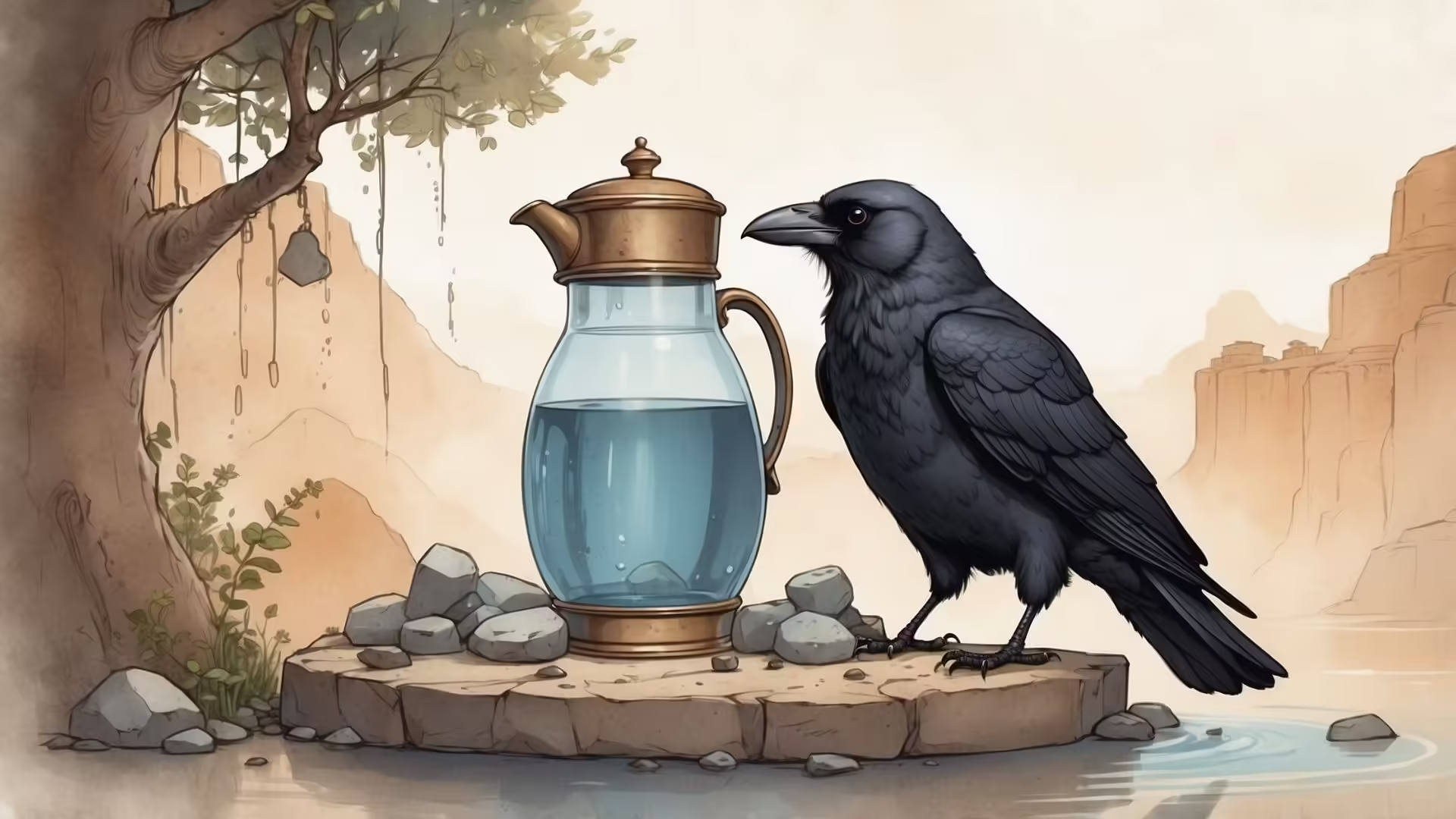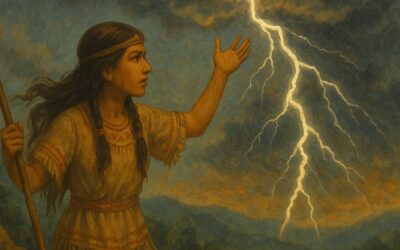- The Gist
- The Crow and the Pitcher: A Lesson in Ingenuity from Aesop’s Fables
- The Story of the Crow and the Pitcher
- The Moral of the Fable: “Necessity Is the Mother of Invention”
- How This Fable Relates to Problem-Solving Today
- Aesop’s Fables: Teaching Life Lessons Through Animal Stories
- The Symbolism of the Crow
- How “The Crow and the Pitcher” Fable Influences Modern Thought
- The Timeless Wisdom of “The Crow and the Pitcher”
- Let’s Talk
- Let’s Learn Vocabulary in Context
The Gist
In the world of Aesop’s Fables, animals often have a clever way of showing us simple yet powerful life lessons. One of these tales, “The Crow and the Pitcher,” tells the story of a thirsty crow who finds a pitcher with water out of reach. Rather than giving up, the crow uses its wits to solve the problem. This fable teaches us about the value of perseverance and creativity in overcoming challenges. That’s just the gist of what this post is about. If you want to dig deeper into the topic, some discussions about it, and learn some key vocabulary from its context, read the post.
The Crow and the Pitcher: A Lesson in Ingenuity from Aesop’s Fables
Among the many fables that Aesop, the ancient Greek storyteller, is known for, “The Crow and the Pitcher” stands out as a unique tale about resourcefulness. This short yet impactful story follows a thirsty crow who stumbles upon a pitcher containing water. However, the water level is too low for the crow to reach it with its beak. The crow’s solution to this dilemma has become a symbol of perseverance, clever thinking, and adapting to difficult situations. Let’s dive into the story and explore the timeless lesson it carries.
The Story of the Crow and the Pitcher
In the fable, a crow finds itself overcome with thirst on a hot day. Desperate for water, it searches until it comes upon a pitcher with a small amount of water at the bottom. The crow quickly realizes that it cannot reach the water by simply lowering its beak. Rather than flying away in disappointment, the crow observes its surroundings and comes up with an idea. It begins dropping pebbles into the pitcher, one by one. As the pebbles accumulate, the water level slowly rises, until eventually, the crow can take a refreshing drink.
This simple act of problem-solving demonstrates that even a small, steady effort can overcome obstacles. It also shows that intelligence and creativity can be just as valuable as strength and speed. The crow doesn’t use brute force to reach the water—it uses its ingenuity.
The Moral of the Fable: “Necessity Is the Mother of Invention”
The lesson of “The Crow and the Pitcher” is often summarized as “necessity is the mother of invention.” The crow’s desperation for water sparks the idea to use pebbles to raise the water level. This phrase highlights the human tendency to find solutions when we need something badly enough. When faced with challenges, we often discover creative ways to solve problems and meet our needs, just as the crow did. The story reminds us that a clear mind and patience can lead to breakthroughs, even when the odds seem stacked against us.
How This Fable Relates to Problem-Solving Today
Though this fable is ancient, its lesson remains as relevant as ever. We encounter many situations in life where straightforward solutions are not an option, and sometimes, it takes a creative approach to overcome these obstacles. Whether it’s finding a way to complete a difficult project, managing limited resources, or finding new ways to reach a goal, thinking outside the box often leads to success. Just like the crow, we can rely on our ability to analyze a situation and make the best of what’s available.
This story also emphasizes that small actions can add up over time. The crow’s persistence in dropping each pebble represents how our efforts, though small on their own, can combine to create meaningful results. It’s a great reminder that sometimes it’s the little things that count the most.
Aesop’s Fables: Teaching Life Lessons Through Animal Stories
Aesop, who is believed to have lived around 600 BCE in ancient Greece, used animals as characters in his fables to convey universal truths about human nature. Animals in these stories often act in ways that reflect human behaviors, making the lessons easy for people of all ages to understand. While the crow in this fable could be seen as a clever individual, it can also represent any one of us who faces a challenge and uses resourcefulness to overcome it.
Aesop’s fables were originally passed down orally, making them accessible to people across different classes and cultures. Each fable carries a moral that’s easy to grasp, which has contributed to their lasting popularity. “The Crow and the Pitcher” is just one example of how Aesop’s stories continue to resonate, reminding us of valuable qualities like patience, cleverness, and determination.
The Symbolism of the Crow
In many cultures, the crow is a symbol of intelligence, adaptability, and problem-solving. Known for their quick thinking and curious nature, crows have often been depicted as wise creatures in myths and folklore. In the context of this fable, the crow’s decision to drop pebbles into the pitcher is a clever solution to a seemingly unsolvable problem. This portrayal aligns with how crows behave in real life—they are known for their resourcefulness and ability to use tools, qualities that are not commonly seen in many other animals.
By choosing a crow as the protagonist, Aesop may have been highlighting the value of intellect and patience over brute force. This fable has served as a reminder that, like the crow, we have the capability to think through our problems, no matter how challenging they seem.
How “The Crow and the Pitcher” Fable Influences Modern Thought
Today, the story of “The Crow and the Pitcher” has a prominent place in discussions about creativity, education, and problem-solving. The idea that innovation often springs from necessity is still a guiding principle in many fields, from engineering to education. The fable encourages students and professionals alike to view challenges as opportunities to test their creativity. Many educators use this fable to inspire children, teaching them that persistence and clever thinking can help them overcome obstacles.
In scientific studies, the problem-solving abilities of real crows have even been examined to understand their intelligence and capacity for tool use. Researchers have observed crows using objects in the environment to access food, much like the fictional crow in Aesop’s tale. This connection between a fable and real-life animal behavior adds an interesting layer to how we view intelligence and adaptability.
The Timeless Wisdom of “The Crow and the Pitcher”
“The Crow and the Pitcher” is more than just a simple fable—it’s a story that reminds us of the power of resilience and the importance of thinking creatively when faced with challenges. In a world that often values speed and strength, this fable suggests that patience and ingenuity are equally powerful tools. Whether we’re students, professionals, or just individuals navigating life’s obstacles, we can all benefit from keeping this crow’s wisdom in mind.
Aesop’s fable continues to inspire us to look for solutions when they’re not immediately obvious and to recognize that even small actions can create lasting change. This timeless story of a thirsty crow, a pitcher, and a handful of pebbles remains a valuable lesson in problem-solving, reminding us that sometimes, it’s our minds, not our muscles, that hold the key to success.
Let’s Talk
Let’s talk about this crow and its clever little trick with the pebbles. You have to admit, there’s something inspiring about it. Here’s this crow, thirsty and facing what seems like an impossible situation—water just out of reach. But instead of flying off to find another source or giving up, it gets creative. It’s like the crow’s saying, “Okay, I can’t reach the water…but what can I do with what I’ve got?” How often do we find ourselves in situations like that, where the solution isn’t obvious or easy?
Sometimes, when we face challenges, it feels natural to want a quick fix or to wish the problem would just disappear. But maybe there’s a lesson here: what if we approach our obstacles the way the crow approached the pitcher? Dropping one pebble after another may not seem like much at first, but with a little patience, those small actions start to add up. Imagine if the crow had thrown in just a couple of pebbles and then given up because it didn’t see immediate results. How often do we do that? We might start working toward a goal or solution, but if we don’t see progress right away, we’re tempted to stop. But just like in the fable, sometimes it’s those seemingly small, consistent steps that make the biggest difference.
And here’s a question to think about: Is there something in your life that feels like a big, unreachable pitcher of water? What would “dropping pebbles” look like in that situation? Maybe it’s working toward a fitness goal, saving money, learning a new skill, or tackling a project. Just like the crow, maybe it’s all about taking that one small step at a time. It’s not always glamorous, and it might not feel groundbreaking, but each step brings us closer.
So, next time you feel like you’re up against something impossible, maybe ask yourself, “What’s my next pebble?” Who knows, by the time you’ve added a few, you might just find yourself sipping from a pitcher of success!
Let’s Learn Vocabulary in Context
Now, let’s break down some words and phrases from the fable that are actually pretty handy in real life too. First up, resourcefulness. This is what the crow demonstrated—using what you have to solve a problem. Being resourceful means thinking on your feet and finding creative solutions, especially when the answer isn’t obvious.
Perseverance is another good one. It’s all about keeping at something, even when it’s tough. The crow didn’t stop after a few pebbles; it kept going. Perseverance helps us reach our goals, even if the progress seems slow at times.
Then there’s obstacle. An obstacle is anything that stands in your way. It can be a physical thing, like a barrier, or something less obvious, like a lack of resources or time. The water level was an obstacle for the crow, but it found a way around it.
Ingenuity is one of my favorite words—it means cleverness and creativity in solving problems. The crow’s pebble idea? Pure ingenuity. Anytime you come up with a new way to solve a problem, you’re using ingenuity.
Adaptability is essential here too. It’s the ability to adjust to new challenges or circumstances. The crow adapted to the situation by figuring out an unusual way to reach the water. Being adaptable means being open to change and finding ways to thrive, even when things don’t go as planned.
Small actions is a great phrase from the story that applies to our lives as well. Small actions might not seem like much individually, but over time, they can lead to big results. Just like the crow’s pebbles added up, small steps toward a goal can make a huge impact.
Determination is another key idea. Determination is the drive to keep going, no matter what. The crow was determined to reach the water, and that determination led it to success. Having determination means pushing through challenges to reach your goals.
Symbolism is something we see in the fable too. The crow represents cleverness and problem-solving, while the pitcher represents a goal or need. Symbolism is when something stands for something else, like how a heart represents love.
And then we have incremental progress—those small, steady steps that build up over time. The crow’s water level rose little by little with each pebble, showing how even small actions can lead to big changes.
Finally, creativity. The crow didn’t take the obvious route; it used its creativity to find a way. Creativity helps us think beyond the usual solutions and come up with new ideas, especially when faced with a problem.
Here’s something to ponder: Which of these words do you feel describes you best? And can you think of a time when small actions or ingenuity helped you achieve something big? Sometimes, the words we associate with ourselves can be the same qualities that guide us through our own “pitcher and pebbles” moments.










0 Comments